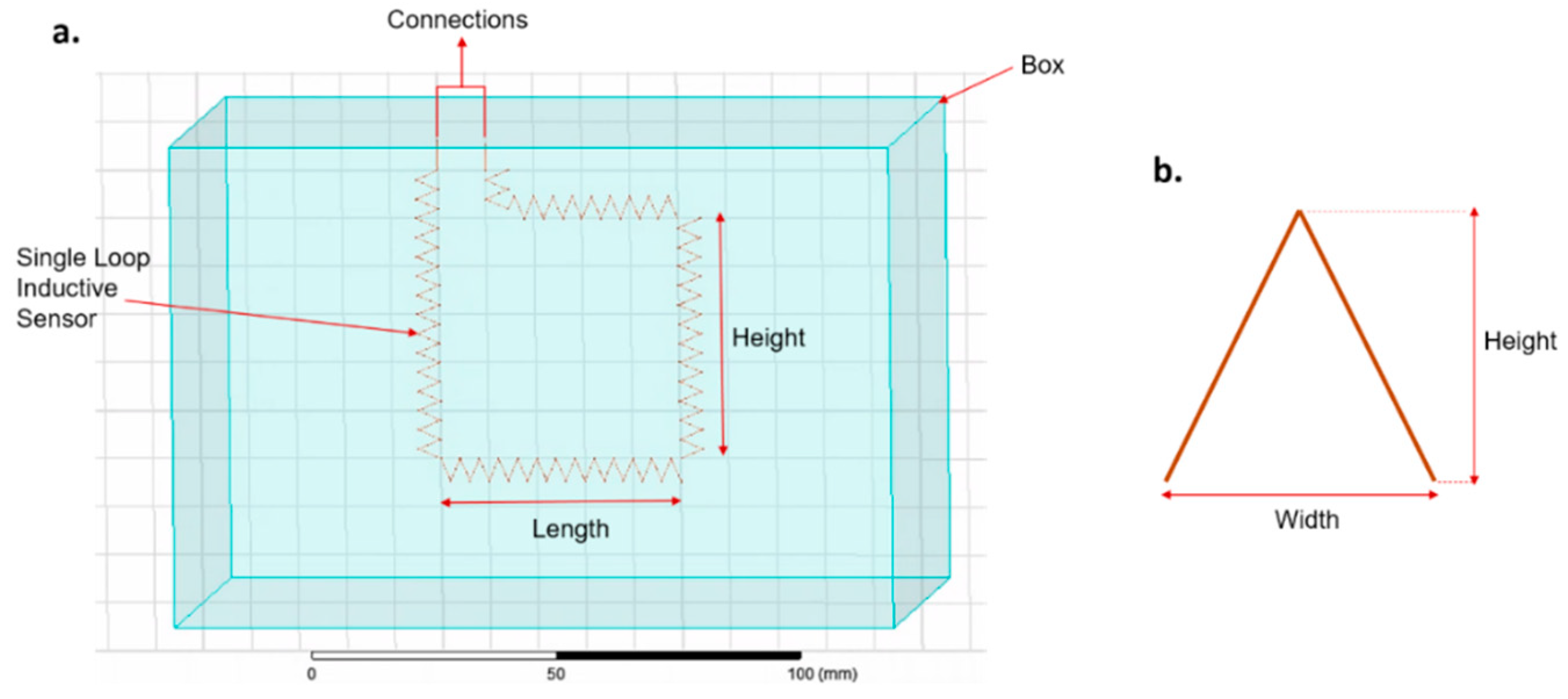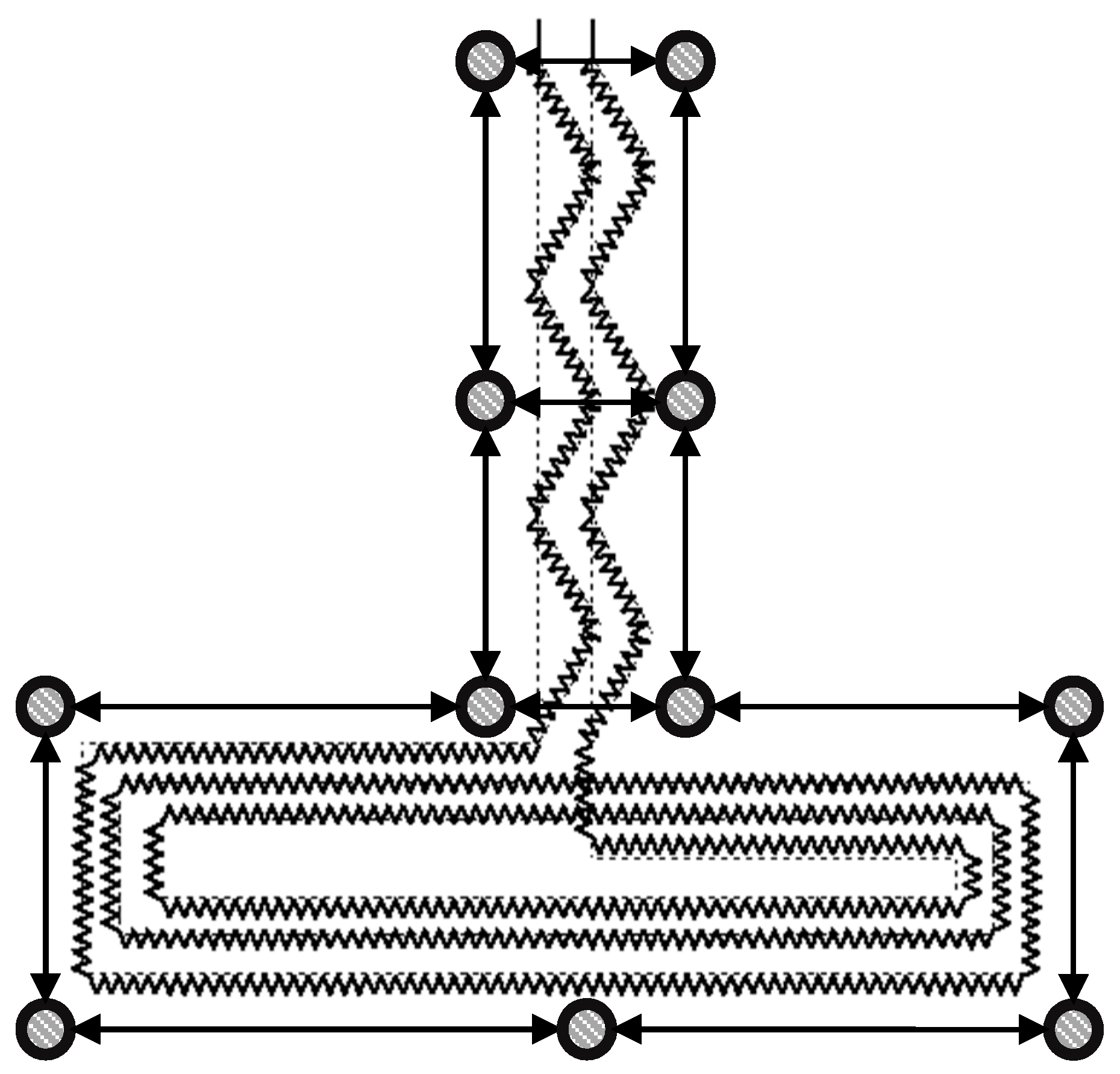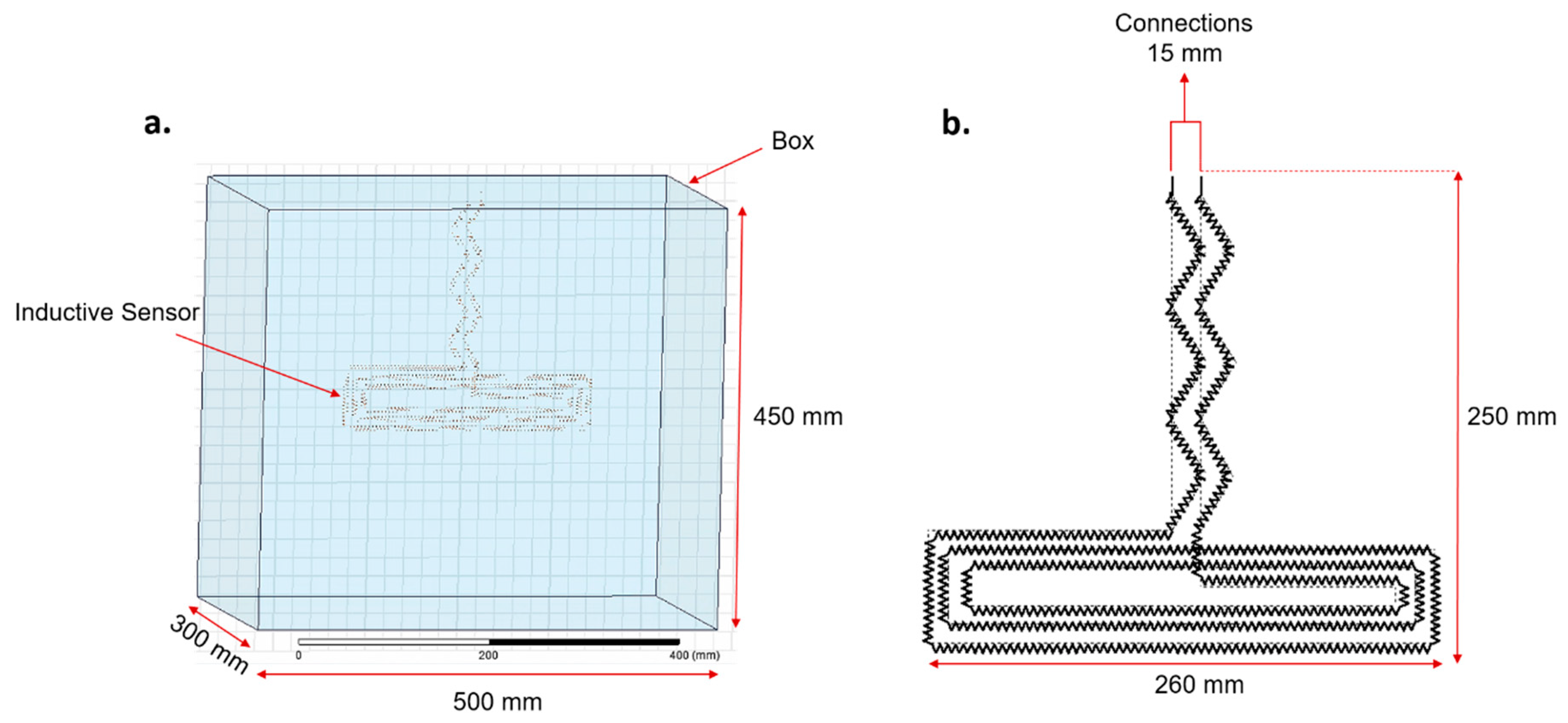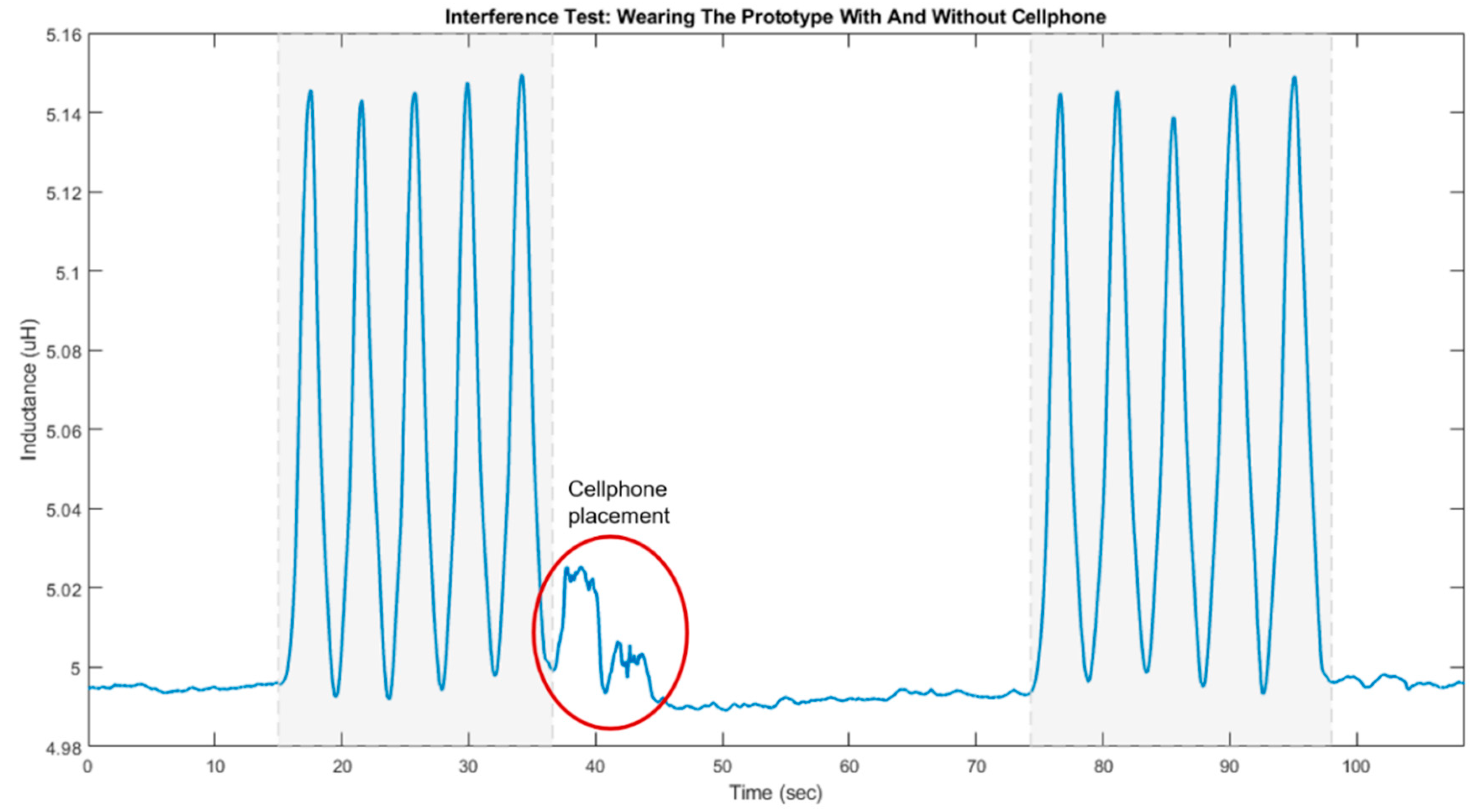Wearable Device to Monitor Back Movements Using an Inductive Textile Sensor
Abstract
1. Introduction
2. Sensor Design and Validation through Simulation
2.1. Configuration of the Inductive Textile Sensor
2.2. Zigzag Pattern
2.3. Simulation Study
- Maximum Number of Passes” defines a limit on the adaptively refined passes that the solver performs.
- Percentage of Error” defines the goal for the Error Energy and Delta Energy.
- Percentage of Refinement Per Pass” determines the number of tetrahedral elements added in the mesh refinement.
- Minimum Number of Passes” defines the minimum number of adaptive passes before the simulation stops.
- Minimum Converged Passes” determines the minimum number of adaptive passes that converged before the solution stops.
3. Sensor Prototype and Evaluation Protocol
3.1. Smart Garment Prototype
3.2. Testing Protocol
- Six repetitions of bending forward, as much as possible and comfortable, at a selected speed without bending the knees;
- Three repetitions of bending to the right, standing straight, bending forward, standing straight, and then bending to the left;
- Three repetitions of rotating the trunk to the right, standing straight, bending forward, standing straight, and then rotating the trunk to the left.
3.3. Interference Test
- In the first phase, the inductance value of the sensor was observed before and after different objects that could potentially interfere with sensor readings were brought close to the unworn garment. The chosen objects included: a copper spool (same material used for the inductive sensor with a length of 5.5 cm and a diameter of 2 cm), a disc-shaped metallic object (an alloy of iron, width = 1 cm, diameter = 3.7 cm), a disc-shaped magnet (width = 0.3 cm, diameter = 2.5 cm), a cellphone (device turned on with Wi-Fi activated), and a human hand. The prototype was fully extended on a table with the inductive sensor facing upward. The object was moved towards the inductive sensor from a distance to the proximity of the coil in vertical direction while the largest face of the objects was facing the coil. The objects were held in the proximity of the inductive sensor for approximately 8 s.
- In the second phase, the participant was asked to wear the prototype and perform three cycles of the following protocol:
- (1)
- Stand upright without moving for approximately 15 s;
- (2)
- Five repetitions of forward bend, as much as possible without bending the knees, at a comfortable speed;
- (3)
- Pick up the phone from the table in front and put it inside the jeans’ back pocket;
- (4)
- Stand upright without moving for approximately 25 s;
- (5)
- Five repetitions of forward bend, as much as possible without bending the knees, at a comfortable speed.
3.4. Outcome Measures
- Current consumption, which is an indicative of the battery life of the sensing unit. A lower current consumption allows for monitoring back movements during longer periods of time, e.g., an entire work shift,
- Inductance value, which is the electrical response of the sensor to externally applied strains. When the user bends forward, the sensors are stretched, resulting in higher inductance values.
4. Experimental Results
4.1. Current Consumption
4.2. Inductance Value
4.3. Comparison of Simulation and Experimental Results
4.4. Results of the Interference Test
5. Discussion
6. Conclusions
Author Contributions
Funding
Conflicts of Interest
References
- Nourollahi, M.; Afshari, D.; Dianat, I. Awkward trunk postures and their relationship with low back pain in hospital nurses. Work 2018, 59, 317–323. [Google Scholar] [CrossRef] [PubMed]
- Videman, T.; Ojajärvi, A.; Riihimäki, H.; Troup, J.D.G. Low back pain among nurses: A follow-up beginning at entry to the nursing school. Spine 1976, 30, 2334–2341. [Google Scholar] [CrossRef] [PubMed]
- Van Hoof, W.; O’Sullivan, K.; O’Keeffe, M.; Verschueren, S.; O’Sullivan, P.; Dankaerts, W. The efficacy of interventions for low back pain in nurses: A systematic review. Int. J. Nurs. Stud. 2018, 77, 222–231. [Google Scholar] [CrossRef] [PubMed]
- Papi, E.; Koh, W.S.; McGregor, A.H. Wearable technology for spine movement assessment: A systematic review. J. Biomech. 2017, 64, 186–197. [Google Scholar] [CrossRef] [PubMed]
- Jaromi, M.; Nemeth, A.; Kranicz, J.; Laczko, T.; Betlehem, J. Treatment and ergonomics training of work-related lower back pain and body posture problems for nurses. J. Clin. Nurs. 2012, 21, 1776–1784. [Google Scholar] [CrossRef] [PubMed]
- Steffens, D.; Maher, C.G.; Pereira, L.S.M.; Stevens, M.L.; Oliveira, V.C.; Chapple, M.; Teixeira-Salmela, L.F.; Hancock, M.J. Prevention of Low Back Pain: A Systematic Review and Meta-analysis. JAMA Intern. Med. 2016, 176, 199–208. [Google Scholar] [CrossRef]
- Straube, S.; Harden, M.; Schröder, H.; Arendacka, B.; Fan, X.; Moore, R.A.; Friede, T. Back schools for the treatment of chronic low back pain - possibility of benefit but no convincing evidence after 47 years of research-systematic review and meta-analysis. PAIN 2016, 157, 2160–2172. [Google Scholar] [CrossRef]
- Engels, J.A.; van der Gulden, W.; Senden, T.F.; van’t Hof, B. Work related risk factors for musculoskeletal complaints in the nursing profession: Results of a questionnaire survey. Occup. Environ. Med. 1996, 53, 636–641. [Google Scholar] [CrossRef]
- Villumsen, M.; Madeleine, P.; Jørgensen, M.B.; Holtermann, A.; Samani, A. The variability of the trunk forward bending in standing activities during work vs. leisure time. Appl. Ergon. 2017, 58, 273–280. [Google Scholar] [CrossRef]
- Cortell-Tormo, J.M.; Garcia-Jaen, M.; Ruiz-Fernandez, D.; Fuster-Lloret, V. Lumbatex: A Wearable Monitoring System Based on Inertial Sensors to Measure and Control the Lumbar Spine Motion. IEEE Trans. Neural Syst. Rehabil. Eng. 2019, 27, 1644–1653. [Google Scholar] [CrossRef]
- Ribeiro, D.C.; Aldabe, D.; Abbott, J.H.; Sole, G.; Milosavljevic, S. Dose-response relationship between work-related cumulative postural exposure and low back pain: A systematic review. Ann. Occup. Hyg. 2012, 56, 684–696. [Google Scholar] [PubMed]
- Nelson, A.; Lloyd, J.D.; Menzel, N.; Gross, C. Preventing nursing back injuries: Redesigning patient handling tasks. AAOHN J. 2003, 51, 126–134. [Google Scholar] [CrossRef] [PubMed]
- Bifulco, P.; Cesarelli, M.; Cerciello, T.; Romano, M. A continuous description of intervertebral motion by means of spline interpolation of kinematic data extracted by videofluoroscopy. J. Biomech. 2012, 45, 634–641. [Google Scholar] [CrossRef] [PubMed]
- Fleury, A.; Sugar, M.; Chau, T. E-textiles in Clinical Rehabilitation: A Scoping Review. Sensors 2015, 4, 173–203. [Google Scholar] [CrossRef]
- Atalay, O. Textile-Based, Interdigital, Capacitive, Soft-Strain Sensor for Wearable Applications. Materials 2018, 11, 768. [Google Scholar] [CrossRef]
- Gonçalves, C.; Ferreira da Silva, A.; Gomes, J.; Simoes, R. Wearable E-Textile Technologies: A Review on Sensors, Actuators and Control Elements. Inventions 2018, 3, 14. [Google Scholar] [CrossRef]
- Trovato, B.; Tobin, G.K.M.; Thorväld, L. Initial Investigations into Characterizing DIY E-Textile Stretch Sensors. In Proceedings of the 4th International Conference on Movement Computing, London, UK, 28–30 June 2017. [Google Scholar] [CrossRef]
- Rezaei, A.; Cuthbert, T.J.; Gholami, M.; Menon, C. Application-based production and testing of a core–sheath fiber strain sensor for wearable electronics: Feasibility study of using the sensors in measuring tri-axial trunk motion angles. Sensors 2019, 19, 4288. [Google Scholar] [CrossRef]
- Esfahani, M.I.M.; Zobeiri, O.; Moshiri, B.; Narimani, R.; Mehravar, M.; Rashedi, E.; Parnianpour, M. Trunk motion system (TMS) using printed body worn sensor (BWS) via data fusion approach. Sensors 2017, 17, 112. [Google Scholar]
- Zhou, G.; Byun, J.H.; Oh, Y.; Jung, B.M.; Cha, H.J.; Seong, D.G.; Um, M.K.; Hyun, S.; Chou, T.W. Highly Sensitive Wearable Textile-Based Humidity Sensor Made of High-Strength, Single-Walled Carbon Nanotube/Poly(vinyl alcohol) Filaments. ACS Appl. Mater. Interfaces 2017, 9, 4788–4797. [Google Scholar] [CrossRef]
- Martinot-Lagarde, P.; Sartene, R.; Mathieu, M.; Durand, G. What does inductance plethysmography really measure? J. Appl. Physiol. 1988, 64, 1749–1756. [Google Scholar] [CrossRef]
- Catrysse, M.; Puers, R.; Hertleer, C.; Van Langenhove, L.; Van Egmond, H.; Matthys, D. Towards the integration of textile sensors in a wireless monitoring suit. Sensors 2004, 114, 302–311. [Google Scholar] [CrossRef]
- Zhong, J.; Kiourti, A.; Sebastian, T.; Bayram, Y.; Volakis, J.L. Conformal Load - Bearing Spiral Antenna on Conductive Textile Threads. AWP Lett. 2016, 16, 230–233. [Google Scholar] [CrossRef]
- Dionisi, A.; Marioli, D.; Sardini, E.; Serpelloni, M. Autonomous Wearable System for Vital Signs Measurement With Energy-Harvesting Module. IEEE Trans. Instrum. Meas. 2016, 65, 1423–1434. [Google Scholar] [CrossRef]
- Coosemans, J.; Hermans, B.; Puers, R. Integrating wireless ECG monitoring in textiles. Sensors 2006, 130–131, 48–53. [Google Scholar]
- Koo, H.R.; Lee, Y.J.; Gi, S.; Khang, S.; Lee, J.H.; Lee, J.H.; Lim, M.G.; Park, H.J.; Lee, J.W. The effect of textile-based inductive coil sensor positions for heart rate monitoring. J. Med. Syst. 2014, 38, 1–12. [Google Scholar] [CrossRef]
- Wijesiriwardana, R. Inductive fiber-meshed strain and displacement transducers for respiratory measuring systems and motion capturing systems. IEEE Sens. J. 2006, 6, 571–579. [Google Scholar] [CrossRef]
- Tormene, P.; Bartolo, M.; De Nunzio, A.M.; Fecchio, F.; Quaglini, S.; Tassorelli, C.; Sandrini, G. Estimation of human trunk movements by wearable strain sensors and improvement of sensor’s placement on intelligent biomedical clothes. Biomed. Eng. Online 2012, 11, 1–8. [Google Scholar] [CrossRef]
- Mattmann, C. Body Posture Detection Using Strain Sensitive Clothing. Available online: https://www.research-collection.ethz.ch/bitstream/handle/20.500.11850/13843/eth-30914-02.pdf (accessed on 7 February 2020).
- Fava, J.O.; Lanzani, L.; Ruch, M.C. Multilayer planar rectangular coils for eddy current testing: Design considerations. NDTE Int. 2009, 42, 713–720. [Google Scholar] [CrossRef]
- Sandrolini, L.; Reggiani, U.; Puccetti, G. Analytical calculation of the inductance of planar zig-zag spiral inductors. Prog. Electromagn. Res. 2013, 142, 207–220. [Google Scholar] [CrossRef]
- Ansoft. Maxwell 3D Guide v11.1. REV2.0. 2005. Available online: http://ansoft-maxwell.narod.ru/en/CompleteMaxwell3D_V11.pdf (accessed on 7 February 2020).
- Andreozzi, E.; Gargiulo, G.D.; Fratini, A.; Esposito, D.; Bifulco, P. A contactless sensor for pacemaker pulse detection: Design hints and performance assessment. Sensors 2018, 18, 2715. [Google Scholar] [CrossRef]
- Limits of Human Exposure to Radiofrequency Electromagnetic Energy in the Frequency Range from 3 kHz to 300 GHz. Available online: https://www.canada.ca/en/health-canada/services/publications/health-risks-safety/limits-human-exposure-radiofrequency-electromagnetic-energy-range-3-300.html (accessed on 25 January 2020).









| Ansys’ Parameters | Sensor 1 | Sensor 2 | Sensor 3 | Sensor 4 | Sensor 5 | |
|---|---|---|---|---|---|---|
| Sensors Characteristics | Between Connections | 10 mm | ||||
| Total Height | 60 mm | |||||
| Total Length | 50 mm | |||||
| Material | Copper | |||||
| Wire Diameter | 0.14 mm | |||||
| Box Characteristics | X | 100 mm | ||||
| Y | 150 mm | |||||
| Z | 100 mm | |||||
| Material | Air | |||||
| Setup | Maximum # Passes | 10 | ||||
| % Error | 5 | |||||
| % Refinement Per Pass | 30 | |||||
| Minimum # of Passes | 5 | |||||
| Minimum Converged Passes | 1 | |||||
| Mesh | Classic, Small | |||||
| Excitation | 1.56 mA | |||||
| Zigzag Dimensions | Width | 2 mm | 4 mm | 6 mm | 8 mm | 10 mm |
| Height | 4.58 mm | |||||
| Inductive Textile Sensor Simulation | ||
|---|---|---|
| Sensor Characteristics | Distance Between Connections | 15 mm |
| Total Height | 250 mm | |
| Total Length | 260 mm | |
| Material Wire Diameter | Copper 0.14 mm | |
| Box Characteristics | X | 500 mm |
| Y | 450 mm | |
| Z | 300 mm | |
| Material | Air | |
| Setup | Maximum # Passes | 10 |
| % Error | 5 | |
| % Refinement Per Pass | 30 | |
| Minimum # of Passes | 5 | |
| Minimum Converged Passes | 1 | |
| Mesh | Classic, small | -- |
| Excitation | -- | 1.56 mA |
| Author | Type of Sensor | Integration into the Garment | Number of Sensors | Recognized Movements | Wireless | Power Consumption (mA) | Weight (g) |
|---|---|---|---|---|---|---|---|
| García Patiño, A. et al. (this paper) | Inductive | Sewn | 1 | Forward Bend | Yes | 20.1 | 78.6 (Circuitry and sensor) |
| Rezaei, A. et al. [18] | Resistive | Sewn | 18 | Forward Bend Lateral Bend Rotation | No | Not specified | Not specified |
| Esfahani, M. I. M. et al. [19] | Resistive | Printed | 12 | Forward Bend Lateral Bend Rotation Mixed Movements | No | Not specified | ≤ 200 (Sensors and garment) |
| Dionisi, A. et al. [24] | Textile Electrocardiography Electrodes (ECG) Inductive sensor (Plethysmography) 1 Accelerometer (Posture Monitoring) | Sewn (Textile Electrodes and Inductive sensor) Pocket and snap buttons (Circuit board) Not specified (Solar Panel) | 2 Textile Electrodes 1 Inductive sensor 1 Accelerometer 1 Solar panel | Forward Fall Back Fall Right and Left Imbalance | Yes | 9.6 (approx.) | 81 approx. (solar panel and circuitry) |
| Tormene, P. et al. [28] | Resistive | Printed | 13 | Forward Bend Lateral Bend | Yes | Not specified | Not specified |
| Mattmann, C. [29] | Resistive | Silicone Film | 21 | Forward Bend Lateral Bend Rotation Lifting Shoulders Slumped Force Upright Arm Postures | Yes | Not specified | Not specified |
© 2020 by the authors. Licensee MDPI, Basel, Switzerland. This article is an open access article distributed under the terms and conditions of the Creative Commons Attribution (CC BY) license (http://creativecommons.org/licenses/by/4.0/).
Share and Cite
García Patiño, A.; Khoshnam, M.; Menon, C. Wearable Device to Monitor Back Movements Using an Inductive Textile Sensor. Sensors 2020, 20, 905. https://doi.org/10.3390/s20030905
García Patiño A, Khoshnam M, Menon C. Wearable Device to Monitor Back Movements Using an Inductive Textile Sensor. Sensors. 2020; 20(3):905. https://doi.org/10.3390/s20030905
Chicago/Turabian StyleGarcía Patiño, Astrid, Mahta Khoshnam, and Carlo Menon. 2020. "Wearable Device to Monitor Back Movements Using an Inductive Textile Sensor" Sensors 20, no. 3: 905. https://doi.org/10.3390/s20030905
APA StyleGarcía Patiño, A., Khoshnam, M., & Menon, C. (2020). Wearable Device to Monitor Back Movements Using an Inductive Textile Sensor. Sensors, 20(3), 905. https://doi.org/10.3390/s20030905






